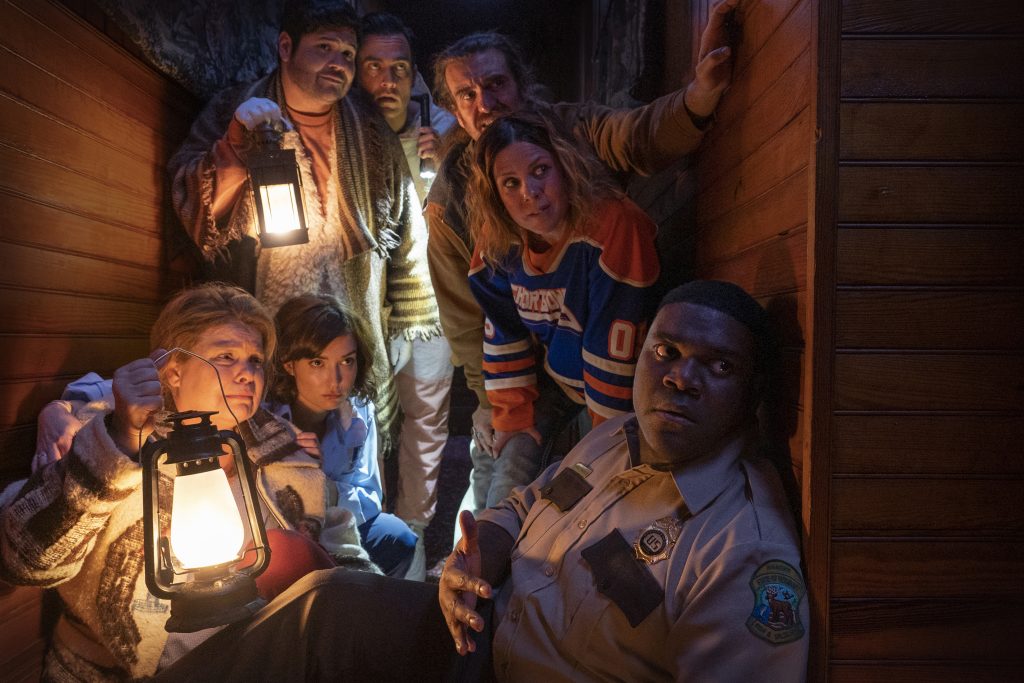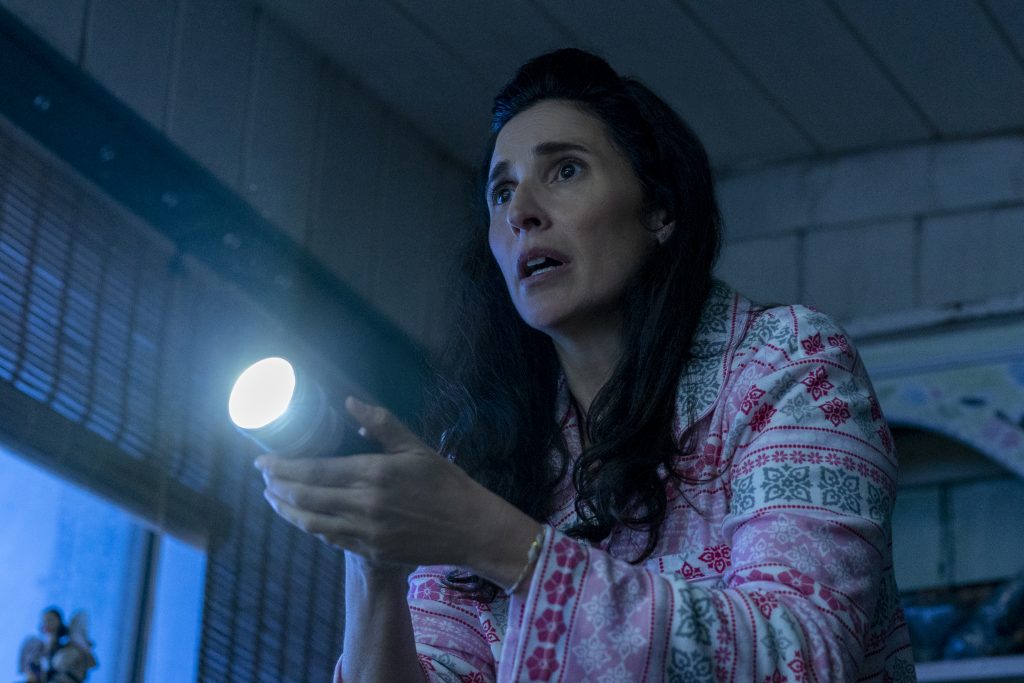July 12, 2021
by Carla Hay

Directed by Josh Ruben
Culture Representation: Taking place in the fictional city of Beaverfield, Vermont, the horror film “Werewolves Within” features a mostly white group of people (with one African American, one Latino and one biracial Native American) representing the working-class, middle-class and wealthy.
Culture Clash: A newly appointed forest ranger arrives in Beaverfield, a rural city that’s in turmoil over a fracking debate and speculation that a killer werewolf is on the loose.
Culture Audience: “Werewolves Within” will appeal primarily to fans of the “Werewolves Within” video game and to people who are interested in memorable horror comedies with quirky characters.

There’s a particular art to blending horror and comedy that “Werewolves Within” achieves with goofy and quirky charm. It’s a well-cast movie that has obvious influences—namely, filmmaker brothers Joel and Ethan Coen 1996 dark comedy “Fargo” and filmmaker Edgar Wright’s 2004 zombie comedy “Shaun of the Dead.” However, “Werewolves Within” (directed by Josh Ruben and written by Mishna Wolff) still keeps the wacky spirit of the Ubisoft video game on which it is based. It’s one of the few video-game-to-movie adaptations that isn’t an embarrassment to the video game.
“Werewolves Within”—which takes places during a snowy winter in the fictional rural city of Beaverfield, Vermont—has a wisecracking tone throughout the film but still maintains an aura of impending doom, as the body count begins to increase. When newly appointed forest ranger Finn Wheeler (played by Sam Richardson) arrives in Beaverfield to start his new job, he arrives in a city that’s plagued by divisive tensions over a fracking controversy. There’s also speculation that a wild animal (possibly a werewolf) is responsible for a recent bloody death of a hunter in the woods, nearly a month earlier.
Finn has his own personal issues going into this job. He’s very insecure about being perceived as a wimp who’s too nice. The first time that viewers see Finn is in his car, as he’s driving to Beaverfield. He’s listening to a self-help motivational podcast or audio recording to learn how to be an assertive alpha male. During the course of the movie, viewers will see that Finn (who was transferred to Beaverfield by the U.S. Forest Service) has to battle his own inner demons and insecurities, as well as the major problems that he comes across in Beaverfield.
“Werewolves Within” moves at such a quick pace that within the first 15 minutes of the film, Finn has met all of the characters who will be in this story. They are:
- Jeanine Sherman (played by Catherine Curtin), the mild-mannered owner of the Beaverfield Inn, where Finn is living.
- Sam Parker (played by Wayne Duvall), an arrogant executive from Midland Gas, the company that wants to buy land in Beaverfield for fracking purposes.
- Cecily Moore (played by Milana Vayntrub), a friendly and talkative mail carrier from the U.S. Postal Service, who lives at the Beaverfield Inn rent-free in exchange for assisting with the inn’s cleaning duties.
- Dr. Jane Ellis (played by Rebecca Henderson), a politically liberal, serious-minded sociologist and environmentalist who is vehemently against anything that she thinks is damaging to the environment, such as what Midland Gas wants to do.
- Emerson Flint (played by Glenn Fleshler), a gruff and reclusive animal trapper who is the subject of a lot of the town’s gossip.
- Devon Wolfson (played by Cheyenne Jackson), a vain millionaire who founded a tech company and who gave up life in a big city for a more laid-back lifestyle in Beaverfield.
- Joaquim Wolfson (played by Harvey Guillén), Devon’s flamboyant and sassy husband who owns a yoga studio in town.
- Trisha Anderton (played by Michaela Watkins), an uptight neurotic who has a passion for crafting and is the owner of Anderton Farms, which has been in her family for 90 years.
- Pete Anderton (played by Michael Chernus), Trisha’s politically conservative, lecherous husband who has a wandering eye and wandering hands when it comes to women who aren’t his wife.
- Gwen Sieczkowski (played by Sara Burns), a tough-talking mechanic who had a somewhat secret affair with Pete.
- Marcus (played by George Basil), Gwen’s boyfriend who is unemployed, financally broke and very dimwitted.
These residents of Beaverfield have various opinions of what Midland Gas wants to do in Beaverfield. Beaverfield Inn owner Jeanine is reluctant to sell her property to Midland Gas, even though the company is offering her a lot of money to sell. Devon and Joaquim, who identify as progressive liberals, are inclined to be against what Midland Gas wants to do.
Meanwhile, Trisha, Pete, Gwen and Marcus think that Midland Gas will bring a lot of business to Beaverton, and they want to profit from it as much as possible. Cecily hasn’t expressed a strong opinion one way or another. But she does tell Finn that she likes her living arrangement, and that she hopes that the Beaverfield Inn won’t be sold to Midland Gas, which would demolish the inn for fracking activities.
The first time that Cecily and Finn meet, it’s at the inn, and there’s an immediate attraction between them. Finn isn’t as obvious about his attraction to Cecily when they first meet, because he tells her that he has a girlfriend named Charlotte, who’s in the city where he used to live. Charlotte is never seen in the movie, but her phone conversations with Finn make it clear to viewers that she likes to nag and henpeck Finn and doesn’t really respect him.
Finn decided to transfer to Beaverfield as part of his goal to be an alpha male, by taking on a challenge outside of his comfort zone. His relationship with Charlotte is somewhat in limbo because he doesn’t know how long he might be in Beaverfield. Meanwhile, Cecily notices that Finn and Charlotte’s relationship is on shaky ground. Cecily isn’t afraid to tell Finn what she thinks about it.
Because she’s a mail carrier who knows a lot of the personal business of the Beaverfield residents, Cecily is Finn’s main source of information and gossip about what’s been going on in Beaverfield. She tells Finn that Jeanine’s husband left Jeanine to run off to Belize with another woman. Cecily is also the one to tell Finn about Pete and Gwen’s affair, which appears to be over. Pete’s wife Trisha and Gwen’s boyfriend Marcus don’t know about the affair.
Finn doesn’t get a friendly welcome from Emerson. Immediately after Finn arrives in Beaverfield, Cecily gives Finn a written complaint about Emerson from Dr. Ellis, who has accused Emerson of illegal trapper activities in her complaint. When Finn goes over to Emerson’s cabin to investigate, Emerson (carrying a rifle and wearing wolf hide with the wolf’s head still attached) angrily chases Finn off of his property.
A huge snowstorm soon hits the area, leaving all transportation to and from Beaverfield temporarily suspended. Somehow, everyone in this story except for Emerson ends up at the Beaverfield Inn for shelter. And that’s when the killings start with a vengeance.
“Werewolves Within” has such distinct characters that it’s very easy to tell all of them apart from each other. The movie has fun with spoofing stereotypes. Dr. Sherman is an unsmiling, “gloom and doom” type who might or might not be a mad scientist. Gay couple Devon and Joaquim are fussy and argumentative. Trisha and Pete are superficial, materialistic and show hints of being racist and homophobic.
Although there aren’t many set pieces in this movie, which takes place in a very confined area, the production design is done well for this low-budget film. (“Werewolves Within” takes place in Vermont, but the movie was actually filmed in New York state.) Of particular note is the Axe Den, a recreational room that’s on the Beaverfield Inn property. It’s Cecily’s favorite place to hang out, and she introduces Finn to an empty Axe Den during the snowstorm.
The Axe Den is a kitschy place filled with vintage arcade games and a jukebox that has mostly pop songs from the 1990s. Ace of Base’s hit “The Sign” is prominently featured in “Werewolves Within,” with great comedic effect. And it should come as no surprise that the Axe Den is where the movie’s biggest showdown happens.
The very self-aware comedy of “Werewolves Within” doesn’t come at the expense of delivering a genuinely engaging mystery. Dr. Ellis has been able to determine in her makeshift lab at the inn that a wolf-like animal is responsible for this killing spree. However, some of the people trapped at the Beaverfield Inn aren’t convinced. Who or what is the real killer? The answer is revealed at the end of the movie.
All of the cast members handle their roles with aplomb, even though some characters verge on parody. Most of the emotional core of the film is with Finn and Cecily, who have to navigate their attraction to each other during the growing terror about the killer on the loose. Richardson and Vayntrub have believable chemistry as a would-be couple caught in this precarious situation. Their comedic timing is one of the highlights of “Werewolves Within.”
The comedy in the movie isn’t for everyone, because some viewers might find it to be too glib or too on-the-nose. But for everyone else—especially for people who like horror comedies with a cheeky tone— there’s a lot that’s appealing about “Werewolves Within.” This movie would make a great double feature with 2020’s “The Wolf of Snow Hollow,” another werewolf horror movie that combines comedy with a murder mystery.
Ruben’s direction of “Werewolves Within” keeps it at a brisk pace (the movie’s total running time is 97 minutes), so there’s little chance of boredom setting in with viewers. The movie doesn’t over-rely on slapstick comedy but instead derives a lot of comedy from how the cast members interpret the snappy dialogue. “Werewolves Within” is the type of horror film where it’s very entertaining to watch these characters for the entire movie, even if you’d never want to be stuck in snowstorm with most of them.
IFC Films released “Werewolves Within” in select U.S. cinemas on June 25, 2021, and on digital and VOD on July 2, 2021.
